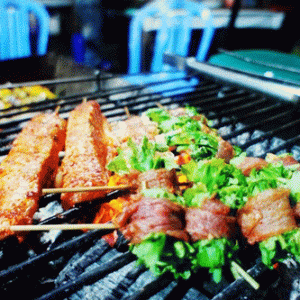Northwest Vietnam is a region of breathtaking landscapes, home to towering mountains, lush valleys, and ethnic minority communities with rich cultural traditions. One of the most fascinating aspects of this region is its cuisine, shaped by the rugged terrain, cool climate, and indigenous ingredients. Unlike the refined delicacies of Hanoi or the bold flavors of central Vietnam, Northwest Vietnam food embraces simplicity, natural flavors, and slow-cooked techniques that enhance the essence of local produce.
If you’re a traveler with a love for authentic food experiences, Northwest Vietnam offers a unique culinary adventure. Let’s explore some must-try dishes of this mountainous region.
The Essence of Northwest Vietnam food
The food of Northwest Vietnam reflects the customs of its ethnic communities such as the H’Mong, Thai, Tay, and Dao. Each group has distinct culinary methods, often relying on open-fire cooking, fermenting, and drying to preserve ingredients in the cooler climate. You’ll find meals of fresh herbs, bamboo shoots, forest mushrooms, and wild-caught meats, all prepared using age-old techniques passed down through generations.
Signature Dishes of the Region
Smoked buffalo meat
One of the most famous specialties of Northwest Vietnam food is smoked buffalo meat or thit trau gac bep. This is a traditional meat product of Black Thai people in Sa Pa originally to reserve food for the rainy season. Local chefs often use buffalo’s thigh and loin and marinate it with ginger, pepper, chilly pepper and mac khen (a local spice). After a few hours of hanging over a fire, it turns from bright red to dark reddish brown. This process gives the meat a deep smoky flavor and a chewy, jerky-like texture. People often enjoy it as a snack or pair it with a glass of corn wine.
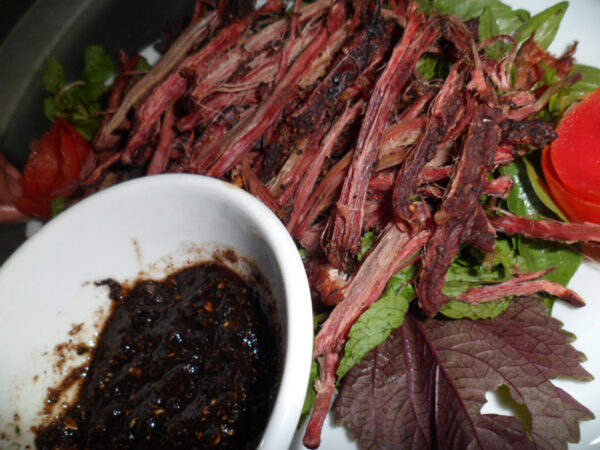
Smoked buffalo meat
Pa Pinh Top
Pa Pinh Top, in the Thai ethnic language, means folded grilled fish. The dish features freshwater fish, typically caught from mountain streams. The preparation of this dish is more complicated than the usual way of preparing fish. First, the fish will be scaled and gutted, and the upper half of the body will be filleted from the back of the head to the tail. Pa Pinh Top requires many spices mixed together, including herbs, green onions, dill, basil, lemongrass, onions, ginger, garlic and fresh chili, crushed and pounded, then mixed with fish sauce, salt and MSG. The seasoning is mixed with the fish intestines and placed back inside the fish. The fish is then folded horizontally, clamped on two bamboo sticks and grilled over a charcoal stove. The result is a fragrant, flavorful dish that captures the freshness of the region’s rivers.
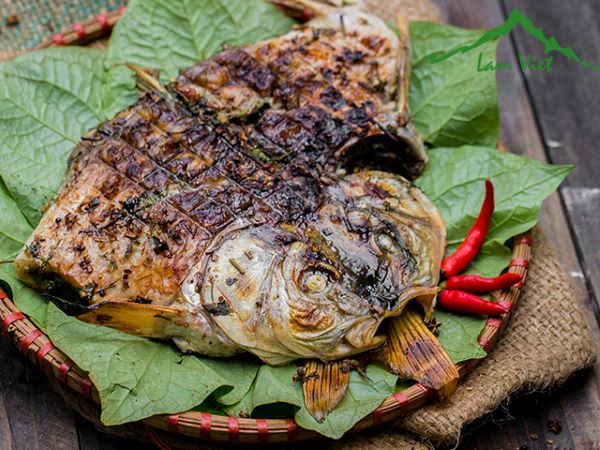
Pa Ping Top – Folded grilled fish
Five-color sticky rice
One of the most visually stunning dishes in Northwest Vietnam cuisine, the five-color sticky rice is an indispensable part of the Tày ethnic community in the provinces of Ha Giang or Sapa. Traditionally served on special occasions, this dish now appears in daily meals across the Northwest. The sticky rice is dyed naturally with plant and fruit extracts to create five vibrant colors—purple, red, yellow, green, and white. Each color represents different aspects of life as well as the five elements, making this dish a staple for festivals and celebrations among the ethnic groups.
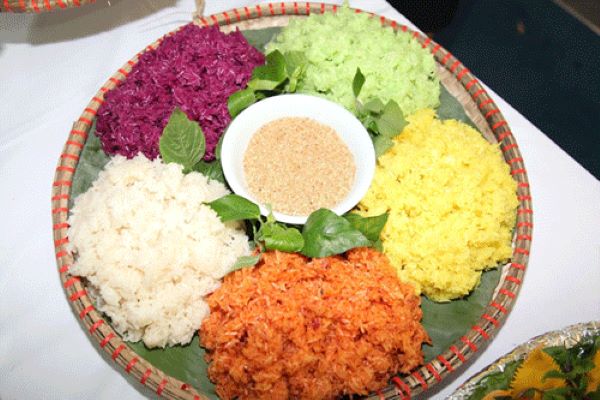
Five-color sticky rice
Thang Co
Thang Co is the most famous and adventurous dish in Northwest Vietnam. Originating from China, the dish soon became a traditional dish of the H’mong people. Most traditionally, Thang Co makes use of all parts of the horse, including meat and organs. As the dish spreads in popularity, you can also find versions made with beef, buffalo, or pork.
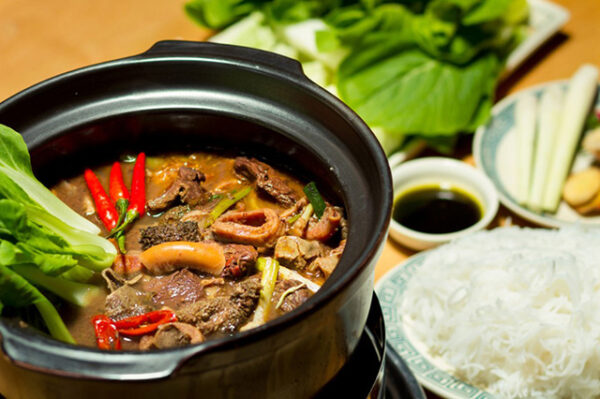
Thang Co is the most famous dish in Northwest Vietnam
The cooking method of this dish is similar to hotpot, using a large pot of broth with herbs such as cardamom, ginger, star anise, lemongrass and local spices. The stewing process takes several hours but results in a delicious, rich broth that has been well-known in highland markets for centuries. While the taste can be intense for first-timers, it is a must-try for those looking to experience the full depth of highland cuisine. In this mountainous area, Thang Co is especially popular on cold and chilly days.
The role of unique spices and ingredients
Northwest Vietnam’s flavors rely on rare mountain spices and herbs from the surrounding forests. One standout ingredient is mac khen, a type of wild pepper that gives dishes a citrusy, numbing heat similar to Chinese Sichuan peppercorn.
Other popular ingredients include dổi seeds (used for marinating meats) and cải mèo (a highland mustard green with a slightly bitter taste).
Local beverages to complement Northwest Vietnam food
No meal in Northwest Vietnam is complete without a traditional drink. The highland communities are known for their corn wine, a strong yet smooth liquor brewed from fermented corn. Another favorite is apple wine, made from wild-grown apples, which has a fruity yet slightly tart taste. These local brews pair perfectly with smoked meats and grilled dishes, enhancing the bold flavors of the cuisine.
Experiencing Northwest Vietnam food on your travels
To truly savor the flavors of Northwest Vietnam, head to ethnic minorities markets and roadside eateries in regions like Sapa, Dien Bien, Lai Chau and Son La. These places offer authentic, home-cooked meals where you can watch the cooking process and interact with local chefs. Homestays in ethnic villages also provide opportunities to learn traditional cooking techniques and dine with local families. If you’re visiting in spring or autumn, you may be lucky enough to experience regional festivals where locals gather to share dishes prepared with fresh seasonal ingredients. The Bauhinia Flower Festival in Dien Bien and the Gau Tao Festival of the H’Mong people are great cultural events where food plays a central role.
For travelers who fall in love with Northwest Vietnam food, consider bringing home some of its signature ingredients. Local markets sell vacuum-sealed smoked buffalo meat, packets of mac khen pepper, and fermented bamboo shoots—perfect for recreating the flavors of the highlands in your kitchen.
In our experience, not all eateries in the region are always available—many only prepare meals upon advance booking. To ensure you don’t miss out on the best local specialties, research and call ahead to check availability or make a reservation. Or, let us take care of it for you. Vietnam Paradise Travel offers Sapa tours and North Vietnam tours including customized meals tailored to your preferences, ensuring a seamless and flavorful dining experience. If you are planning a journey to Vietnam, don’t miss the opportunity to explore the stunning scenery of the Northwest and the unforgettable culinary experience that awaits.

